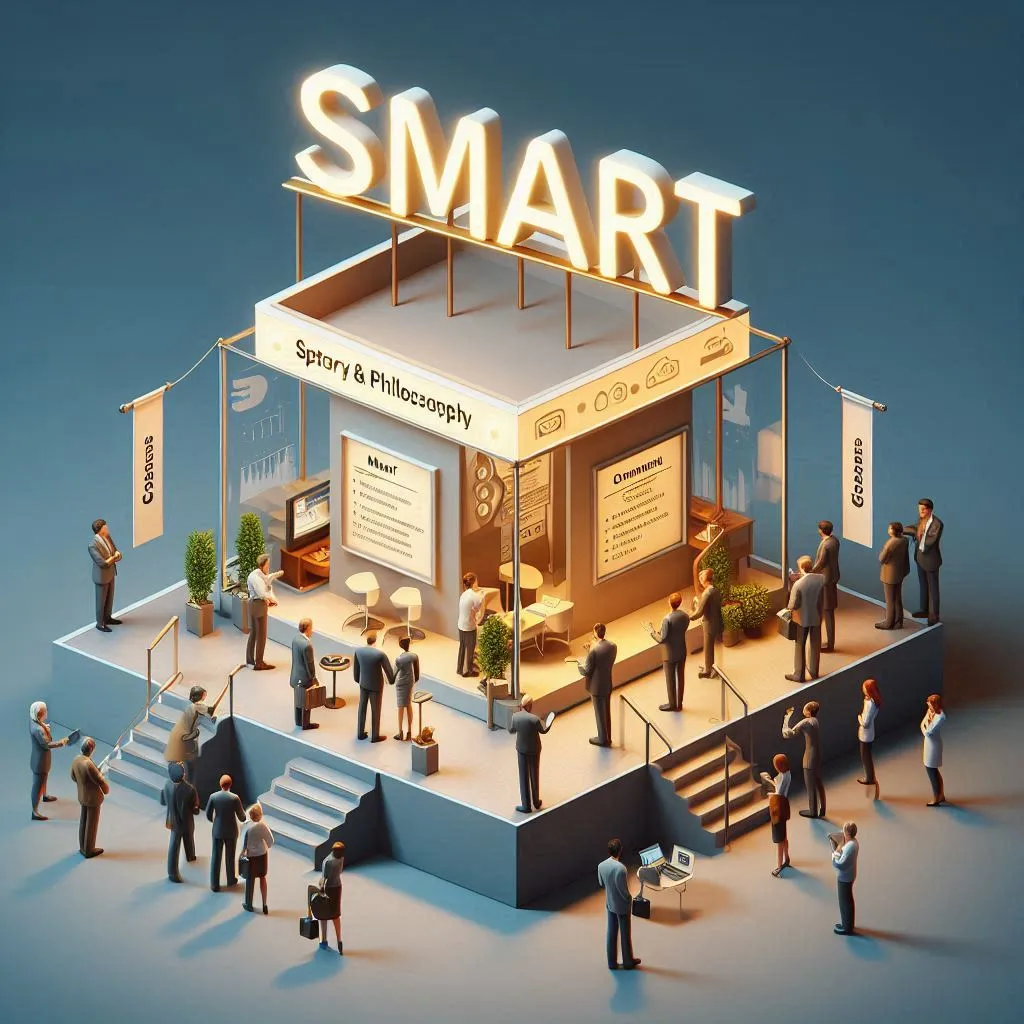Guaranteeing Exhibition Success with the SMART System: A Comprehensive Guide to Professional Booth Construction

فهرست مطالب
- 1 History and Philosophy of SMART Goals: From Management to Booth Building
- 2 Top 5 Benefits of SMART Goals in Exhibition Booth Building
- 3 Case Study: Smart Booth Construction for Tech Solutions Company
- 4 7 Golden Tips for Combining SMART Goals with Creative Booth Design
- 5 Possible disadvantages and ways to avoid them
- 6 Frequently Asked Questions (FAQ)
- 7 Conclusion: Smart booth construction is guaranteed success.
Booth Media – If you’re looking to maximize your trade show profits, setting SMART goals can be a solid roadmap to success. In this article, we’ll take an in-depth look at this smart framework, its benefits to trade show booths, and how to implement it using the experiences of leading companies.
History and Philosophy of SMART Goals: From Management to Booth Building
The idea of SMART goals was first introduced in 1981 by George Doran , an American consultant. He designed the framework to combat the common ambiguity in setting business goals. Today, SMART is recognized as a key tool not only in project management, but also in the design and implementation of exhibition stands .
What does SMART stand for?
- Specific: Clear and unambiguous goals.
- Measurable: Ability to measure progress.
- Achievable: Consistent with resources and capabilities.
- Relevant: Aligned with the overall business goals.
- Time-bound: Has a specific time frame.
Top 5 Benefits of SMART Goals in Exhibition Booth Building
1. Maximize Focus on Target Audience
Designing your booth based on SMART goals will help you convey your brand message to your key audience in a focused and engaging way. For example, if your goal is to attract IT managers, your booth should be designed with elements such as showcasing software products or providing interactive demos.
2. Smart Time and Budget Management
According to statistics from the US Exhibition Research Center , 40% of companies face unexpected costs at exhibitions due to poor planning. By setting goals, you can more accurately schedule and budget the stages of booth construction, staff recruitment, and marketing.
3. Increase executive team motivation
When goals are clear and achievable , booth staff feel more accountable and perform better. Training the team based on SMART criteria (e.g., “Attract 100 leads on day one”) increases motivation and coordination.
4. Optimize resources and new technologies.
Using digital tools such as QR Code, augmented reality (AR), and analytics platforms in your booth design allows you to accurately measure visitor engagement. This data helps you allocate resources intelligently.
5. Accurately assess ROI (return on investment).
By determining measurable indicators (such as the number of leads, direct sales, or social media engagement), you can quantitatively analyze the success of the exhibition and improve future strategies.
1. Planning stage: from idea to implementation
- Specify the end goal:
- Example: “Attract 200 qualified leads from marketing managers in the technology industry.”
- Use of technology in design:
- Installing touch screens to collect contact data.
- Modular booth design for reuse in future exhibitions.
2. Implementation and monitoring
- Train the team to prioritize target audiences.
- Use time management apps (like Trello) to track tasks.
3. After the exhibition: analysis and improvement
- Compare results with initial goals.
- Record strengths and weaknesses in the final report.
Case Study: Smart Booth Construction for Tech Solutions Company
Challenge:
Tech Solutions faced the problem of attracting irrelevant audiences and wasting resources at a previous trade show.
SMART-based solution:
- Specific: Recruit 50 IT managers from mid-sized companies.
- Measurable: Use digital surveys at the booth to measure the quality of leads.
- Achievable: Design an interactive booth with product demos tailored to the needs of managers.
- Relevant: Providing free whitepapers about current industry challenges.
- Time-bound: Data collection by the end of the third day of the exhibition.
Results:
- 70% increase in qualified leads.
- Save 30% on marketing costs.
7 Golden Tips for Combining SMART Goals with Creative Booth Design
1. Use good lighting to draw attention to key products.
2. Design a break area in the booth to increase visitor engagement.
3. Create interactive stations such as online competitions with instant prizes.
4. Use sustainable materials to enhance brand image.
5. Partner with industry influencers to increase footfall.
6. Host live webinars from the booth to engage online audiences.
7. Use real-world data to set goals for the next exhibition.
Possible disadvantages and ways to avoid them
- Excessive strictness:
- Solution: Flexibility in dealing with unexpected situations.
- Focusing solely on numbers:
- Solution: Consider quality criteria such as visitor satisfaction.
Frequently Asked Questions (FAQ)
- Are SMART goals useful for small exhibitions?
Yes! Even at local exhibitions, setting clear goals helps optimize resources. - How to manage booth construction costs with SMART?
By dividing the budget into specific sections (design, advertising, personnel) and tracking each item.
Conclusion: Smart booth construction is guaranteed success.
SMART goals are not just a planning tool, but a roadmap for turning trade shows into golden business opportunities. By combining this framework with creative booth design and cutting-edge technology , you can exponentially increase your productivity.
📞 Ready to transform your booth design? Contact
our experts today designa booth that fits your SMART goals and brand identity!
Keywords: exhibition booth construction, smart booth design , SMART goals at the exhibition, exhibition space optimization, exhibition time management, exhibition return on investment ( ROI ).
Suggested internal links:
- Dedicated booth design services
- Examples of successful booth construction projects
- A guide to choosing sustainable materials for your booth
By following these principles, you will not only achieve stunning results at your next trade show, but you will also solidify your brand’s position as an industry leader! 🚀


